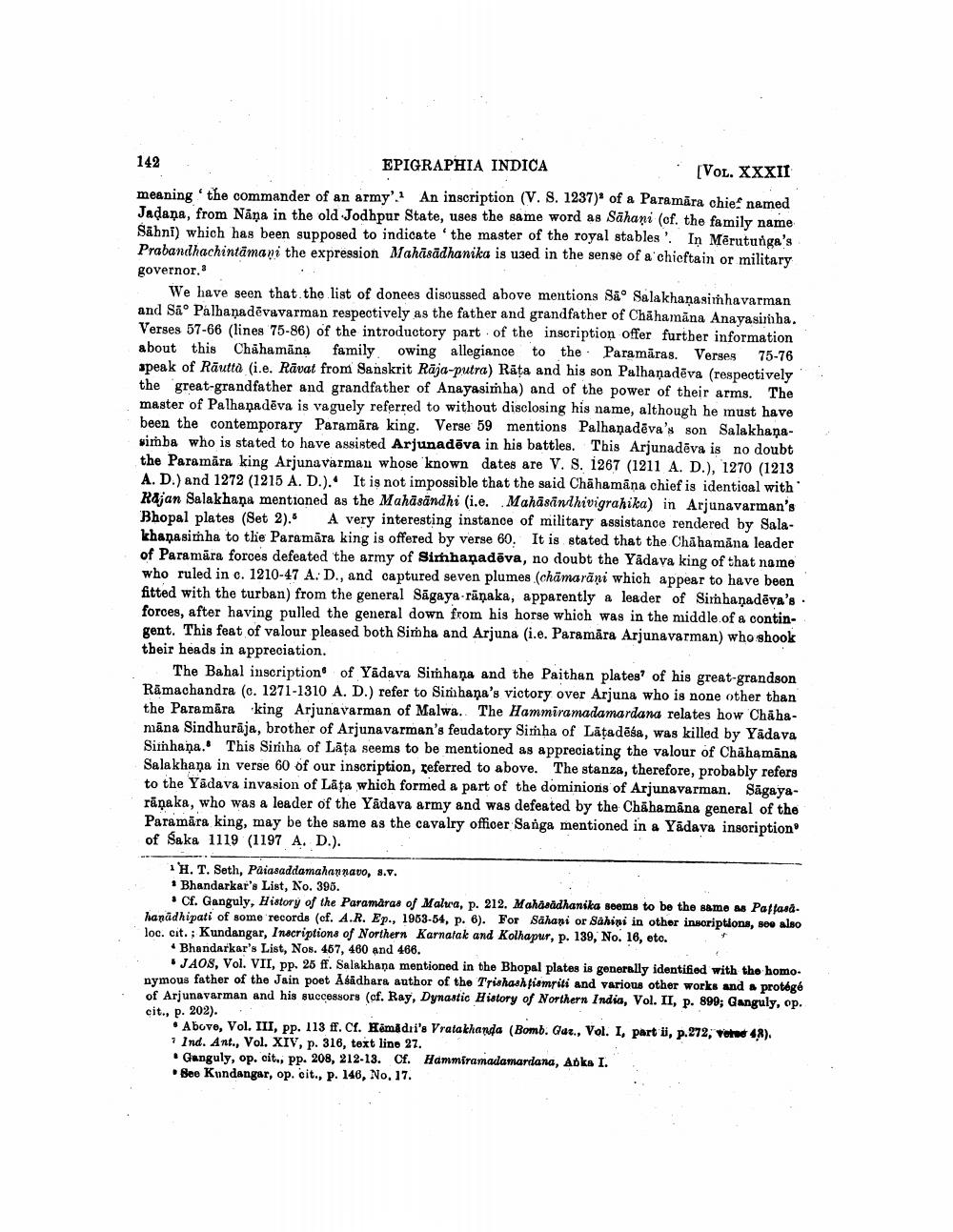________________
142
EPIGRAPHIA INDICA
[VOL. XXXII
meaning the commander of an army'. An inscription (V. S. 1237) of a Paramara chief named Jadana, from Nana in the old Jodhpur State, uses the same word as Sahani (cf. the family name Sahni) which has been supposed to indicate the master of the royal stables'. In Merutunga's Prabandhachintamani the expression Mahāsādhanika is used in the sense of a chieftain or military
governor,
We have seen that the list of donees discussed above mentions Sã° Salakhanasimhavarman and São Palhanadevavarman respectively as the father and grandfather of Chahamana Anayasimha. Verses 57-66 (lines 75-86) of the introductory part of the inscription offer further information about this Chahamana family owing allegiance to the Paramāras. Verses 75-76 speak of Rautta (i.e. Ravat from Sanskrit Raja-putra) Rața and his son Palhanadeva (respectively the great-grandfather and grandfather of Anayasimha) and of the power of their arms. The master of Palhanadeva is vaguely referred to without disclosing his name, although he must have been the contemporary Paramāra king. Verse 59 mentions Palhanadeva's son Salakhanasimba who is stated to have assisted Arjunadeva in his battles. This Arjunadeva is no doubt the Paramara king Arjunavarman whose known dates are V. S. 1267 (1211 A. D.), 1270 (1213 A. D.) and 1272 (1215 A. D.). It is not impossible that the said Chahamana chief is identical with Rajan Salakhana mentioned as the Mahäsändhi (i.e. Mahāsanlhivigrahika) in Arjunavarman's Bhopal plates (Set 2). A very interesting instance of military assistance rendered by Salakhanasimha to the Paramāra king is offered by verse 60. It is stated that the Chahamana leader of Paramara forces defeated the army of Simhaṇadēva, no doubt the Yadava king of that name who ruled in c. 1210-47 A. D., and captured seven plumes (chamarani which appear to have been fitted with the turban) from the general Sagaya-ranaka, apparently a leader of Simhanadēva's forces, after having pulled the general down from his horse which was in the middle of a contingent. This feat of valour pleased both Simha and Arjuna (i.e. Paramara Arjunavarman) who shook their heads in appreciation.
The Bahal inscription of Yadava Simhana and the Paithan plates of his great-grandson Ramachandra (c. 1271-1310 A. D.) refer to Simhana's victory over Arjuna who is none other than the Paramāra king Arjunavarman of Malwa. The Hammiramadamardana relates how Chahamāna Sindhuraja, brother of Arjuna varman's feudatory Simha of Laṭadeśa, was killed by Yadava Simhana. This Sinha of Lața seems to be mentioned as appreciating the valour of Chahamana Salakhana in verse 60 of our inscription, referred to above. The stanza, therefore, probably refers to the Yadava invasion of Lata which formed a part of the dominions of Arjunavarman. Sāgayaranaka, who was a leader of the Yadava army and was defeated by the Chahamana general of the Paramāra king, may be the same as the cavalry officer Sanga mentioned in a Yadava inscription" of Saka 1119 (1197 A. D.).
1 H. T. Seth, Paiasaddamahan navo, s.v. Bhandarkar's List, No. 395.
Cf. Ganguly, History of the Paramaras of Malwa, p. 212. Mahäsädhanika seems to be the same as Paffasăhanadhipati of some records (cf. A.R. Ep., 1953-54, p. 6). For Sahani or Sahini in other inscriptions, see also loc. cit.; Kundangar, Inscriptions of Northern Karnatak and Kolhapur, p. 139, No. 16, etc.
Bhandarkar's List, Nos. 457, 460 and 466.
JAOS, Vol. VII, pp. 25 ff. Salakhana mentioned in the Bhopal plates is generally identified with the homonymous father of the Jain poet Asadhara author of the Trishash fiemriti and various other works and a protégé of Arjunavarman and his successors (cf. Ray, Dynastic History of Northern India, Vol. II, p. 899; Ganguly, op. cit., p. 202).
Above, Vol. III, pp. 113 ff. Cf. Hemadri's Vratakhanda (Bomb. Gaz., Vol. I, part ii, p.272, verse 48). Ind. Ant., Vol. XIV, p. 316, text line 27.
Ganguly, op. cit., pp. 208, 212-13. Cf. Hammiramadamardana, Abka I.
·
See Kundangar, op. cit., p. 146, No. 17.




